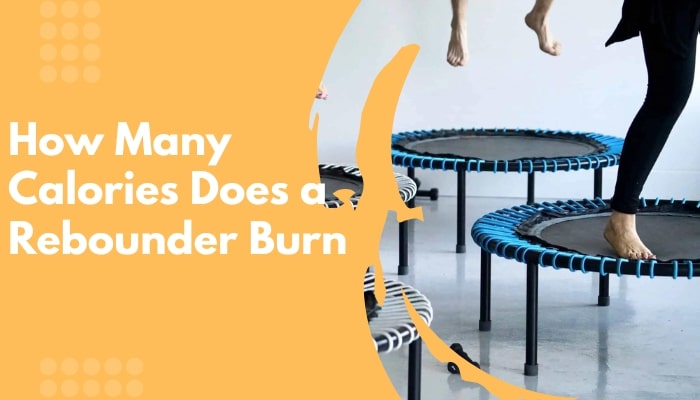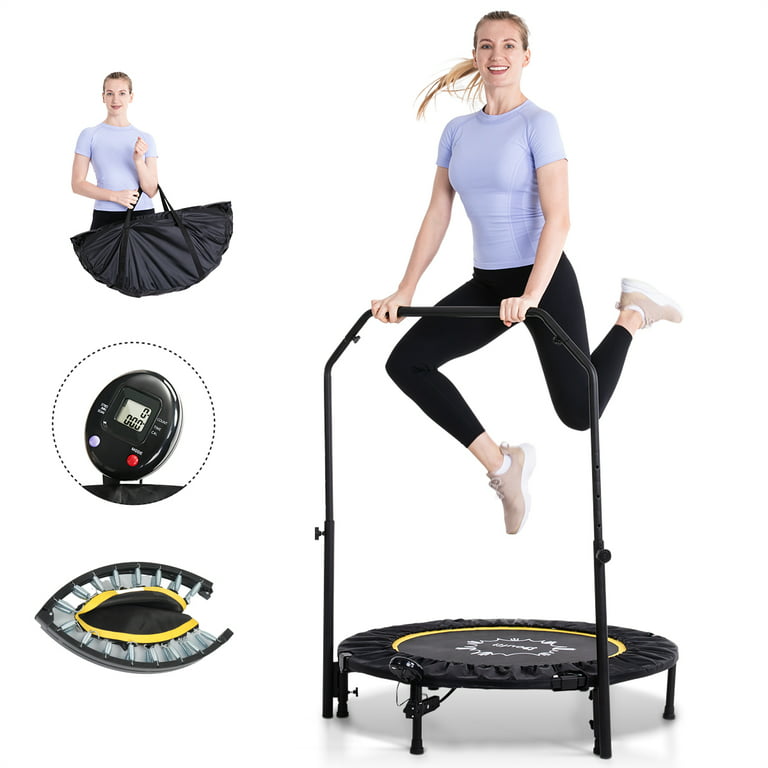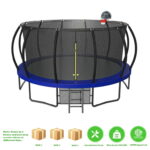To treat trampoline burns, apply cool water and aloe vera, and avoid tight clothing. Keep the affected area clean and covered with a non-stick bandage.
Trampoline parks and backyard bouncers are increasingly popular for family fun and fitness. Yet, this surge in popularity comes with a spike in trampoline-related injuries, including skin abrasions known as trampoline burns. Caused by friction against the trampoline surface, these superficial wounds can be both painful and annoying.
Safely managing these injuries at home is crucial for quick healing and minimizing discomfort. Knowing effective, simple remedies and care techniques is valuable for anyone who enjoys the high-flying thrills of trampolining. This guide provides concise, straightforward tips, ensuring swift and proper trampoline burn treatment without overwhelming the reader with medical jargon.

Credit: www.amazon.com
The Mystery Of Trampoline Burns
Trampoline burns, a term that mystifies many, refers to the uncomfortable red marks users often experience after an exhilarating jump session. These marks are not burns from heat or sun, but rather from friction. This post dives into what trampoline burns are and effective ways to identify and treat them. Understanding the phenomenon can help prevent discomfort and ensure safe, fun trampoline use for everyone. Let’s unravel this mystery together!
What Are Trampoline Burns?
Trampoline burns are misleading by name. They are skin abrasions caused by sliding or falling onto the trampoline material. As skin rubs against the surface, friction occurs, which may lead to these red, sometimes painful, areas. Recognizing trampoline burns is key to treating them quickly and effectively. The goal is to leap without the ouch!
Identifying Trampoline Skin Friction Injuries
Spotting a trampoline burn is straightforward. Symptoms include:
- Red, irritated patches of skin
- Mild swelling or warmth at the injured spot
- A stinging sensation when touched
These injuries resemble carpet burns and usually emerge on exposed areas like legs, arms, and elbows. Prompt recognition leads to swift action, creating a better bouncing experience for all.
From here, the blog post would continue with a list of 10 effective ways to treat such skin friction injuries, each supported with short, easy-to-understand explanations suitable for readers of all ages.
Credit: www.walmart.com
Immediate Actions To Take Post-burn
Picture this: A day of joyous jumping on a trampoline turns into a moment of pain from a friction burn. Though common, trampoline burns can really sting! Let’s quickly address the steps you should take right after getting a trampoline burn.
Cleaning The Wound
The first step is cleaning the wound. A clean wound heals better. Follow these easy steps:
- Rinse the burn with cool water for a few minutes to remove any debris.
- Gently wash the area with mild soap and lukewarm water.
- Pat the burn dry with a clean cloth or paper towel.
Reducing The Pain
Next, putting the sting at ease is key. Consider these immediate remedies:
| Action | Benefit |
| Apply a cool compress | Diminishes heat; eases discomfort. |
| Use aloe vera gel | Soothes skin; supports healing. |
| Take over-the-counter pain relief | Alleviates pain; reduces inflammation. |
Minimizing Swelling
Swelling can prolong discomfort. To minimize swelling, stick to these tips:
- Avoid using ice directly on the skin.
- Elevate the affected area above the heart if possible.
- Wear loose clothing to prevent further irritation.
Simple Home Remedies For Relief
Got a trampoline burn? Don’t worry! Your kitchen and bathroom might hold the perfect solutions for quick relief. Discover simple and natural ways to soothe your skin. These home remedies are easy to use and very gentle on your skin.
Applying Aloe Vera
Aloe vera cools and heals the skin. It’s perfect for trampoline burns. Just follow these steps:
- Wash your hands.
- Cut an aloe vera leaf and squeeze out the gel.
- Gently apply the gel to the burn.
- Let it dry on its own.
- Repeat 2-3 times a day until the burn feels better.
Using Honey For Healing
Honey has natural healing powers. It can help your burn heal faster. Here’s what to do:
- Clean the burned area gently.
- Spread a thin layer of honey on a bandage.
- Place it over the burn.
- Change the bandage 3 times a day.
Cold Compress For Comfort
A cold compress can reduce swelling and pain. Use it with these steps:
- Wrap ice in a clean cloth.
- Hold it on the burn for 15 minutes.
- Remove it for 15 minutes.
- Repeat several times a day.

Credit: stridestrong.com
Topical Treatments And Over-the-counter Solutions
Topical Treatments and Over-the-Counter Solutions play a crucial role in healing trampoline burns. These remedies provide comfort and aid in the recovery process. Effective and easy to apply, they prevent infections and reduce discomfort. Let’s delve into the treatments that can offer both protection and pain relief.
Antibiotic Ointments
Antibiotic ointments prevent bacteria from invading wounds. An important step in treating minor trampoline burns involves cleaning the area gently. Then, applying a thin layer of antibacterial cream boosts healing and wards off infection.
- Neosporin – A popular choice, containing active ingredients that speed up healing.
- Bacitracin – Great for sensitive skin, it keeps the wound moist and infection-free.
- Polysporin – A less allergenic option, suitable for those allergic to Neomycin in Neosporin.
Protective Creams And Gels
Protective creams and gels shield the skin from further irritation. They form a barrier on the skin, which helps in keeping it safe. This barrier also maintains the area moist, which is necessary for healing.
| Product | Use |
|---|---|
| Aloe Vera Gel | Soothes the burn and hydrates the skin |
| Calendula Cream | Promotes skin repair and reduces inflammation |
Pain Relief Medications
Over-the-counter pain relief medications ease the discomfort from trampoline burns. These can be in the form of creams, sprays, or oral tablets. Remember to stick to the recommended dosage.
- Ibuprofen – Reduces inflammation and relieves pain.
- Acetaminophen – Eases the pain and is less harsh on the stomach.
- Lidocaine spray or cream – Numbs the affected area providing temporary relief.
Preventive Measures For Future Sessions
Before you leap back onto the trampoline, let’s dive into actions that can protect your skin from future burns. These steps are not only simple but also crucial for a safe bouncing experience.
Proper Trampoline Etiquette
Mastering the right moves and rules on a trampoline reduces friction burns. Here are key tips to follow:
- One at a time: Multiple people increase collision risk.
- Controlled jumps: Less wild movements mean less burn risk.
- Bare feet rule: Shoes can cause unwanted friction.
The Role Of Protective Gear
Wearing the right gear is essential to prevent burns. Consider these options:
- Long-sleeved shirts and pants: They shield the skin.
- Trampoline gloves: Protect hands during flips and tricks.
- Non-slip socks: Offer grip and minimize skin rub.
Selecting The Right Type Of Trampoline
The type of trampoline you choose impacts safety. Look for these features:
- Safety net enclosures: They prevent falls.
- Quality padding: It covers springs and frame edges.
- Right size: A trampoline fitting your space means safer jumping.
When To Seek Professional Medical Help
Trampoline burns, commonly known as friction burns, can turn a day of fun into a painful experience. While minor burns usually heal with home care, at times, they may require professional medical attention. Understanding when to seek professional medical help is essential to prevent complications and ensure proper healing.
Recognizing Signs Of Infection
A burn can get infected without proper care. Spot these signs early:
- Increased pain, swelling, or redness
- Pus or other drainage
- Fever over 38°C (100.4°F)
- Foul smell from the burn site
- Red streaks spreading from the burn
The Need For Medical Intervention
Don’t hesitate to reach out for help if these symptoms appear:
- Burn covers a large area of the body
- Burns located on face, joints or genitals
- Affecting someone with a weak immune system
- Symptoms of shock, such as pale, clammy skin
- Difficulty breathing after getting a burn
Long-term Skin Care After Severe Burns
Severe burns on a trampoline need more care:
- Consult a burn specialist for a treatment plan
- Follow up regularly to monitor healing
- Consider physical therapy if mobility gets affected
- Use recommended scar treatment creams and sunscreens
- Stay hydrated and maintain good nutrition for skin healing
Frequently Asked Questions Of How To Treat Trampoline Burns: 10 Effective Ways!
What Causes Trampoline Skin Burns?
Trampoline burns, also known as friction burns, are caused by repeated sliding or falling on the trampoline’s surface. This friction generates heat, leading to burns on exposed skin.
Can Trampoline Burns Be Treated At Home?
Yes, minor trampoline burns can be treated at home. Clean the affected area gently with soap and water. Apply a soothing ointment and cover with a sterile bandage. Rest and avoid further friction on the burn.
How To Prevent Trampoline Burns?
Preventing trampoline burns is possible. Wear clothing that covers the skin, use trampoline safety pads, and ensure proper jumping technique. Also, regularly check the trampoline for rough spots.
Are Trampoline Burns A Sign Of Improper Use?
Not necessarily, but frequent burns might indicate improper jumping techniques or a lack of protective gear. Following safety guidelines and using the equipment correctly can help reduce the risk.
Conclusion
Navigating the discomfort of trampoline burns can challenge even seasoned jump enthusiasts. With the ten effective methods we’ve discussed, relief is within reach. Always prioritize skin care post-injury, and for persistent or severe cases, seek medical attention. Remember, prevention is key to keeping your bounce worry-free!


